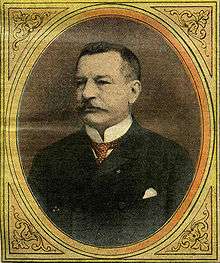1910 Belgian general election
Partial general elections were held in Belgium on 22 May 1910.[1] The result was a victory for the Catholic Party, which won 49 of the 85 seats up for election in the Chamber of Representatives.[2]
| |||||||||||||||||||||||||||||||||||||||||||||||||||||||||||||||||
85 of the 166 seats in the Chamber of Representatives | |||||||||||||||||||||||||||||||||||||||||||||||||||||||||||||||||
|---|---|---|---|---|---|---|---|---|---|---|---|---|---|---|---|---|---|---|---|---|---|---|---|---|---|---|---|---|---|---|---|---|---|---|---|---|---|---|---|---|---|---|---|---|---|---|---|---|---|---|---|---|---|---|---|---|---|---|---|---|---|---|---|---|---|
| |||||||||||||||||||||||||||||||||||||||||||||||||||||||||||||||||
| |||||||||||||||||||||||||||||||||||||||||||||||||||||||||||||||||
Under the alternating system, elections were only held in five out of the nine provinces: Antwerp, Brabant, Luxembourg, Namur and West Flanders.
Results
Liberal Adolphe May defeated Catholic Emile de Lalieux de La Rocq in Nivelles and socialist Joseph Bologne defeated liberal Léopold Gillard in Namur. All other representatives were either re-elected, or succeeded by candidates of the same party. Notably, Camille Huysmans (socialist of Antwerp) was elected for the first time.
| Party | Votes | % | Seats won | Total seats | +/- |
|---|---|---|---|---|---|
| Catholic Party | 676,849 | 53.11 | 49 | 86 | +8 |
| Liberal-Socialist Kartels | 243,063 | 19.07 | 17 | 20 | +5 |
| Liberal Party | 236,467 | 18.55 | 15 | 36 | 0 |
| Belgian Labour Party | 85,326 | 6.69 | 6 | 25 | 0 |
| Christian Democratic Party | 11,494 | 0.90 | 0 | 1 | 0 |
| Other parties | 21,300 | 1.67 | 0 | 0 | 0 |
| Catholic Workers' Party | - | - | 0 | 0 | -9 |
| Invalid/blank votes | 32,258 | – | – | - | - |
| Total | 1,306,757 | 100 | 87 | 168 | +4 |
| Source: Belgian Elections | |||||
gollark: More keywords → more complexity in the language/parsing/whatever, more stuff programmers have to know.
gollark: For all (values of) f there exists a (value) g such that f (x, y) = (g x) y. In other words, you can convert any function which takes two values as a tuple or something to a curried one. I think.
gollark: I knew it would eventually be useful setting that as my status!
gollark: What part of ∀f ∃g (f (x,y) = (g x) y) did you not understand?
gollark: Also written as ∀, I think.
References
- Nohlen, Dieter; Stöver, Philip (31 May 2010). Elections in Europe: A data handbook. Nomos Verlagsgesellschaft. p. 289. ISBN 978-3-8329-5609-7.
- Nohlen & Stöver, p308
This article is issued from Wikipedia. The text is licensed under Creative Commons - Attribution - Sharealike. Additional terms may apply for the media files.

